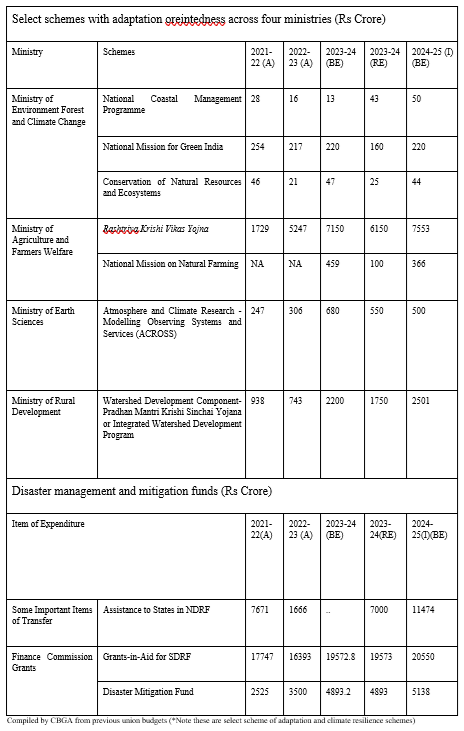Climate change is the most significant global challenge of the 21st century. India is the third largest emitter of greenhouse gases, as well as one of the worst affected countries from the impact of extreme weather events. The effect of climate change on India’s socio-economically vulnerable populations underscore the necessity for the country’s climate action policy and budgetary focus, especially for adaptation measures. An egalitarian approach is essential for mitigating climate stress across various sectors such as health, water, and agriculture. The rural economy needs to be supported by strategic budgetary allocation for adaptation focused interventions.
This article examines how the interim Budget for the financial year 2024-25 prioritised India’s climate adaptation actions and identifies emerging needs for resilience building against climate-induced risks. It seeks to pinpoint key areas for focus in the full Budget that will come after the general elections later this year.
Mitigation measures in Budget
The interim Budget is focused on mitigation strategies. Through cohesive policy and budgetary support, India has made notable progress toward its climate action goals, as outlined in its Nationally Determined Contributions (NDCs), by increasing renewable energy capacity.
Budgetary allocation for the renewable energy sector has significantly risen over the past three years, evident in the increased funding for the ministry of new and renewable energy. The allocation for central sector schemes promoting renewable energy rose to Rs 12,850 crore in the Budget estimate, up from Rs 7,848 crore in the revised estimate for 2023-24.
Despite this substantial support for climate mitigation programmes, adaptation financing lacks focused budgetary support. This support is crucial for addressing the vulnerabilities and stresses that climate change imposes on the country’s economic and non-economic assets. The interim Budget could have adopted a more focused and dedicated strategy for building adaptation capacity and resilience to climate risks.
Climate change adaptation strategies diluted
Despite a positive focus on mitigation, the Budget has diluted India’s climate adaptation strategies by merging various existing adaptation-specific schemes into a broader mission or scheme, or redirecting them as secretariat roles to ministries. Notable examples of important adaptation elements that have been either discontinued or subsumed include the National Adaptation Fund and schemes under the Ministry of Environment, Forest, and Climate Change (MOEFCC).
Similarly, programmes under the ministry of agriculture and farmers welfare, such as the Rainfed Area Development, National Project on Soil Health and Fertility, and Promotion of Agricultural Mechanisation for in-situ crop residue management, have been integrated into the Rashtriya Krishi Vikas Yojana. This underscores the need for a dedicated strategy for climate adaptation to ensure long-term climate resilience.

In addition to launching the Blue Economy 2.0, another adaptation-specific scheme that received budgetary priority this year was the National Mission on Natural Farming. The current interim Budget’s allocations for adaptation-specific schemes remain scattered across various ministries, highlighting the importance of an inter-sectoral approach with clear climate adaptation-oriented objectives and emphasising the need for a strong focus on adaptation measures alongside mitigation.
Climate-induced disasters and extremes also lead to significant losses and damages, which has led to the emergence of Loss and Damage financing as the third pillar of climate finance. Recognising this, there has been a global call to action, resulting in the operationalisation of the Global Loss and Damage Fund, recognised by COP28 and supported by India. India has domestic efforts and budgetary provisions for disaster resilience, with funds allocated for disaster management and mitigation through transfers and grants from the Finance Commission.
The National Disaster Management Fund, recommended by the 15th Finance Commission and created last year, reflects the increasing allocation towards disaster management and mitigation funding. However, there is a need for a separate policy framework specifically designed for climate-induced disasters, especially for the most vulnerable populations.
This situation highlights India’s successful climate action achievements, such as meeting its original NDC targets for mitigation. However, there is a clear need to extend budgetary support across all aspects of climate action, particularly adaptation. The upcoming Budget and future climate action strategies should consider:
- Adopting a focused climate adaptation strategy and dedicated allocations for adaptation schemes.
- Enhancing climate adaptation-oriented objectives across various sectors to improve the intersectoral approach.
- Clearly defining climate-induced risks and disasters with a robust policy and institutional framework to leverage the forthcoming global fund for loss and damage response financing.
- Exploring opportunities to meet carbon sink and storage targets under the NDCs and achieve NET ZERO by providing greater budgetary support to adaptation programmes, such as the National Afforestation Programme and the Green India Mission.
While mitigation efforts deserve recognition, neglecting adaptation poses significant risks to the country’s future. The next Budget presents an opportunity to rectify the imbalance. By adopting a dedicated adaptation strategy, enhancing inter-sectoral collaboration, and leveraging global loss and damage finance, India can build resilience and safeguard its development gains from the intensifying impacts of climate change. This comprehensive approach, encompassing both mitigation and adaptation, will position India as a leader in the fight against climate change and ensure a sustainable future for its citizens.


 15 February, 2024
15 February, 2024